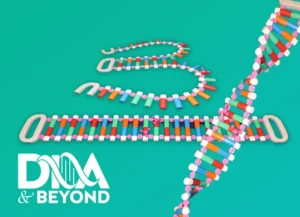Scientists were amazed to discover that DNA conveys its information in specific segments of carefully ordered “letters”. These letters are the famous rungs of the DNA’s double helix, which we will take a closer look at further on in this unit. A typical sequence of many hundreds of these rungs are able to spell out a complete individual message, something like a blueprint containing the instructions for producing a single screw or nut, that will in turn be used in a machine. This message is called a gene.
Let’s use the following thought experiment to picture the gene more clearly. Imagine that a friend came to visit and stay at your house for a couple of days. In the morning, when you go to knock on the guest room door, you notice something odd on the floor: your friend has had some fun with a bag of pasta letters! On the hallway floor, you can see a single, continuous string of pasta letters laid out. It reads:
GOTUPEARLYANDDECIDEDTOGOFORAWALKBUTTHOUGHTITWOULDBE-BESTTOLEAVEAMESSAGEC
IEPMWMQPODDZQYCVXRSJIXXPEKVMTYIAZBHEYTHISWOULDBEAPERFECTDAYTOGRABLUNCHATOURFAVORITEPIZZAPARLOR
Can you make out the message he left for you?
The DNA strings in our cells are arranged much like this sequence of pasta letters, the equivalent of the individual letters being the rungs of the DNA helix. Scattered in between sections that seem to be gibberish, we find whole sentences spelled out. These strings of meaningful messages are what we identify as our genes. The gibberish in between is part of the total DNA sequence, but is not part of any gene. Only those recognized messages, with specified sequences of letters that clearly convey information, are counted as genes.
In other words (referring back to the analogies we first used to describe DNA), a gene is a functional sequence of DNA which acts like a single article in one of the journals housed in Firestone Library. Or, a gene is like a single email that is digitally recorded on the hard drive. Switching to our kitchen example, a gene is like a single French recipe in Julia Child’s box.
Note that in all these analogies, we have used written texts (books, emails, recipes, pasta messages) to envision the gene. The gene is, in fact, shockingly similar to a sentence. One of the biggest shocks is to find that at one end, a gene possesses a triplet of letters (three rungs of the double helix) that act like a capital letter, indicating the start of the encoded piece of information. At the other end, there is another triplet which functions very much like the period at the end of sentence, indicating the end of the message. (In the reality of DNA, many genes would be much longer than any sentence we have ever read in a book or email.) In a way, the most accurate analogy may be that of the recipe, for each gene records an exact sequence of letters (which can be hundreds or even thousands of letters). This long string of letters serves as the blueprint or construction manual for something vital to life: a protein molecule. What exactly are protein molecules? Why are they important and how are they produced? These are questions that we will look at in the following units.


